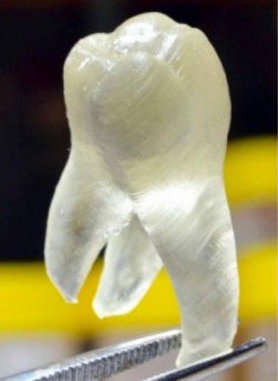
A new 3D printed resin demonstrates the opportunities with that 3D printing process.
The new result is 3D printed teeth that can destroy stray bacteria. Researchers from the Netherlands’ University of Groningen have created a special photo-curable resin that includes antimicrobial quaternary ammonium salts.
These salts perform an important biological task: their positive charge disrupts negative-charged bacterial membranes, rendering them quite dead. In other words, bacteria tend to die if they bump into objects printed with this material.
We’ve seen anti-bacterial 3D print material previously, but that was in filament form. This new composite resin is different in that it can be used in high-resolution 3D printers to produce more personalized and functional objects, such as a set of teeth.
Teeth that kill bacteria. Or at least 99% of them.
Is this a good thing? Perhaps – there are bad bacteria and good bacteria, and such teeth may affect the good as well as the bad.
But that’s not what we’re on about today. We like to view this development as representative of a class of 3D printing solutions that could be nearly limitless.
It’s the idea that common 3D printing materials can be mixed with other substances to create unique materials with unusual properties.
This example simply took existing 3D printing dental resin and mixed in those deadly salts. It’s an approach similar to those metal and wood plastic filaments. They’re usually just plain old PLA mixed with some type of dust. Here we’re mixing resin with dust.
How many unusual resins could be created? What new material properties could be created? Those are difficult questions to answer, simply because there are almost an infinite number of other substances that can be combined with 3D printer resin. And accordingly, there could be a huge number of peculiar materials, too.
We suspect we may se e considerable research in this area, testing a wide variety of substances in resin. This particular project demonstrates what might be possible.
Perhaps we’ll see materials imbued with fragrances, or fabric, or something we haven’t thought of yet. The applications of these new, yet-to-be-invented materials may take us places we hadn’t dreamt of.
Via The Stack

